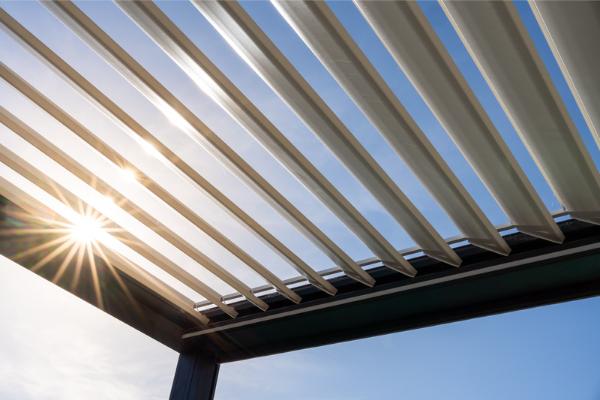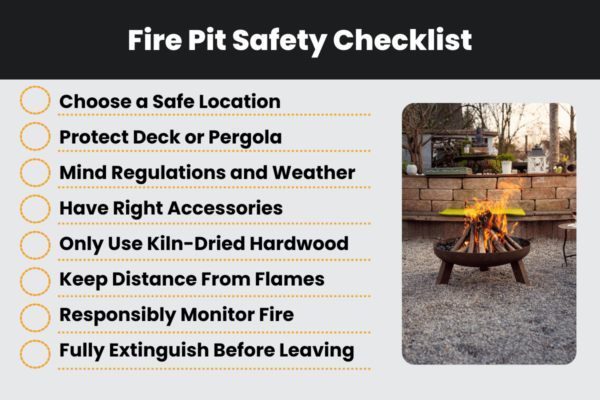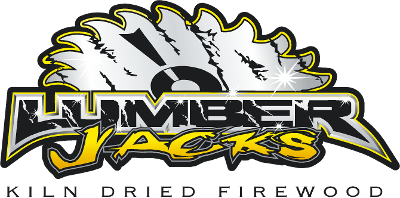Few things in life are more relaxing than sitting around a wood-burning fire pit with family and friends on a summer evening. The wood is crackling and smells terrific. Your guests laugh and chat, and you’re… fretting over fire pit safety.
Wait, that’s not right. You shouldn’t be worried on a lovely night like this. We want you to enjoy the festivities without concern about causing an unfortunate accident. That’s what this blog is for!
You can practice fire pit safety without getting distracted from having fun. The key is knowing what ground rules you must follow beforehand. In this post, we’ll outline nine guidelines for keeping your fire pit safe while having a good time. We’ll also explain why kiln-dried hardwood is the safest type of wood for fire pits.
By the way, if you need some high-quality firewood for your fire pit, we can help you with that. At Lumberjacks, we deliver premium kiln-dried wood throughout the Chicago region.
Now, without further ado, let’s get to those fire pit safety tips!
1. Wisely Choose Where to Place Your Fire Pit
The first essential rule is to choose a safe location for your fire pit. You’ll want to place it more than 10 feet away from any flammable structures, such as your house, your neighbor’s house, fences or sheds. Avoid placing it next to any trees or plants that could catch fire when you use your fire pit.
There should also be plenty of clearance overhead. At best, you want nothing overhanging the fire but the sky.
If you’re setting up a fire in a dense area, there should be at least 20 feet of clearance above the fire. Artificial items like string lights and power lines shouldn’t be above your fire.
No matter where you put your fire pit, the ground beneath it should be level and non-flammable. The best surfaces to place a fire pit on are stone, brick or concrete. Never put it directly on flammable surfaces like a wooden deck or grass.
2. Make Your Fire Pit Safe for a Wood Deck or Pergola
You may be able to use a fire pit around wooden structures like a deck or pergola. However, you must take special care to do it safely.
First, check your city or county codes to ensure the local government allows using a fire pit on a wood deck and under a pergola. If your area does allow it, make note of any specific regulations and then follow these guidelines:
A fire pit on a deck must have a fire pit pad underneath it. Many major hardware stores sell fire pit pads designed to protect the usual things that might be on top of a deck, like lawn chairs. You can also make a pad out of rocks, bricks and metal. This pad should extend two feet in all directions from the fire.
A fire pit underneath a pergola must have proper ventilation. The top of the pergola should be at least ten feet away from the flames, and you should use a spark screen to protect the surrounding structure from catching fire.
Upon completing the fire pit setup, inspect it to ensure it’s in good shape. Consider any thin spots that might be easy for a fire to burn through and make any necessary repairs.

3. Be Mindful of Regulations and the Weather
Local governments may issue no-burn alerts to protect the quality of local air. They often do this when high emissions combine with adverse weather conditions to raise fine particulate pollution to unhealthy levels. Making outdoor fires during these times could result in fines, adverse health effects or out-of-control fires.
You should also avoid lighting fires during the windiest days. As harmless as a mild breeze can be, high winds can easily carry sparks where you don’t want them to go. Burning wood and preexisting poor air quality don’t get along.
4. Have the Right Fire Pit Accessories on Hand
Make sure you have the right tools to easily tend your fire. We recommend long-handled, well-insulated tongs and fire pokers to maneuver logs in the pit safely. You’ll also want a handy first aid kit and a bucket of water to put out the fire when you’re ready to leave. Investing in a fire extinguisher is also never a bad idea.
Never use lighter fluid or gasoline, even if you’re struggling to start a fire. Not only might this make the fire too big, but it can also release toxic fumes into the air. Only use organic material as kindling. Never burn plastic or paper, as these contain further chemicals that are dangerous to inhale.
5. Create a Fire-Stop Buffer
The right placement and fire pit accessories are a great start to a safe fire. But you should never burn a fire without a fire-stop buffer in place. Essentially, you want something around the fire that will lower the risks of it spreading if it does get out of control.
A great way to do this is to dig a trench around your fire pit. It doesn’t have to be very deep, but you do want it to be at least a couple of inches thick. Fill the trench with sand or fire-safe rocks. Do not use river rocks. River rocks are full of moisture and will crack or even explode when exposed to too much heat.
Building a temporary fire? Or don’t have the ability to dig a trench? You can also create a circle of water around your fire in a pinch. Saturate the ground around your fire a few inches thick. Although it doesn’t work as well as a trench, it does lower the risk of your fire spreading significantly.
6. Only Use Kiln-Dried Hardwood
You can also prevent dangerous fire pit problems by choosing the best type of firewood to burn: kiln-dried hardwood.
Kiln-dried hardwood contributes to safety mainly by limiting, if not wholly avoiding, smoke. Kiln-drying reduces moisture in wood most effectively, and moisture is a significant part of what produces smoke.
Hardwood, like oak and maple, is also more effective than softwood, like pine, because hardwood produces consistent, hot flames. Softwood is far more likely to produce excess smoke and burn too quickly, causing sparks to fly from moisture pockets in the wood.
In short, not only does kiln-dried firewood create better, longer fires, but those fires are safer, too.
7. Keep Your Distance from the Flames
Be mindful of how far you’re sitting from the fire pit. Sit about three feet from the flames if you’re in front of a gas fire. You might want to move back another foot if you’re in front of a wood fire. Roll back your sleeves and tie back your long hair when tending the fire.
Always keep your kids and pets more than three feet from the fire. If the kids want to roast marshmallows, have an adult help. Half of pediatric burns occur due to falls into fire pits. So don’t leave any attending children out of your sight.

8. Practice Responsible Fire Pit Monitoring
Stay with your fire for as long as it burns. You don’t want it to spread without your permission! If you take your eyes off it, it can quickly get out of hand.
Many like to enjoy an ice-cold beer alongside a fire, but fire and alcohol don’t mix. Not only does alcohol impede your judgment and reflexes, but it’s also highly flammable. If you and your fellow celebrants just need to have a drink, do so in moderation and keep your water bucket handy.
9. Completely Extinguish Your Fire Before Leaving
When is it safe to leave a fire pit? Not until the ashes in the pit have cooled. Pour out your bucket and use a shovel to mix the water into the ash. This will expedite the cooling process, and you’ll be able to leave when everything’s nice and cool. We recommend double-checking the fire pit the next morning to ensure the fire is still totally out.
Here’s to an Enjoyable Evening with Responsible Fire Pit Safety!
There you have it: the keys to basic fire pit safety! With solid materials and a little technique, you can enjoy a fire that roasts marshmallows without risking your family’s safety.
As mentioned above, we at Lumberjacks do our part to help keep outdoor fires safe in Chicagoland by producing premium kiln-dried firewood. After basking in 200-degree kilns for two days, our firewood produces almost no smoke and burns consistently enough to avoid occasional popping.
If you’d like to enjoy better quality fires in your fire pit, please call (815) 337-1451 or stop by one of our locations in Woodstock or Lake in the Hills.
Editors Note: This blog was originally published in June of 2023 and was updated in January of 2024.









